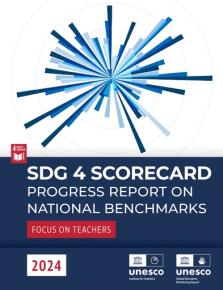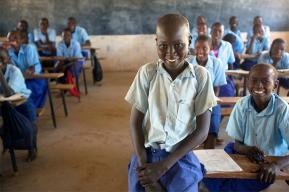
Monitoring SDG 4: Quality
Good quality education cannot be equated with, or reduced to, learning outcomes. Too many children are denied sufficiently trained teachers, good school infrastructure or a safe, non-violent learning environment.
Progress on increasing the proportion of qualified teachers was uneven across regions and education levels between 2015 and 2020. The greatest improvement took place in sub-Saharan Africa, where the share of qualified teachers increased from 53% to 60% in pre-primary education and from 59% to 65% in upper secondary education. Nevertheless, the region is still far from achieving its 2030 benchmarks.
An appropriate learning environment must have adequate water and sanitation facilities, especially for girls. Yet, over 20% of primary schools in Central and Southern Asia and in Eastern and South-eastern Asia lack functional single-sex bathrooms, as do 83% in Mali and 94% in Togo
Electricity is a basic need for a quality learning environment and yet many countries are without it. The share of schools connected to electricity from 2015-2020 rose from 66% to 76% in primary and from 77% to 86% in lower secondary education..
School should be a safe place to learn but attacks on education and military use of schools and universities increased in 2020–21 from 2018–19, notably in Mali and Myanmar. School-related violent acts or threats can be psychological, physical or sexual and occur on school premises but also on the way to school, at home or in cyberspace. They often come about because of unequal power dynamics and are often the result of negative gender norms and stereotypes.

| SDG 4 Targets | GEM Report monitoring chapters | Most recent statistics | GEM Report Blogs |
|---|---|---|---|
| TARGET 4.7: SUSTAINABLE DEVELOPMENT AND GLOBAL CITIZENSHIP | 2023 GEM Report 2021/2 GEM Report 2020 GEM Report 2019 GEM Report 2017/8 GEM Report 2016 GEM Report | 4.7 statistics | View blogs |
| TARGET 4.A: EDUCATION FACILITIES AND LEARNING ENVIRONMENTS | 2023 GEM Report 2021/2 GEM Report 2020 GEM Report 2019 GEM Report 2017/8 GEM Report 2016 GEM Report | 4.A statistics | View blogs |
| TARGET 4.C: TEACHERS | 2023 GEM Report 2021/2 GEM Report 2020 GEM Report 2019 GEM Report 2017/8 GEM Report 2016 GEM Report | 4.C statistics | View blogs |









